View in other NatureServe Network Field Guides
NatureServe
Montana
Utah
Wyoming
Idaho
Wisconsin
British Columbia
South Carolina
Yukon
California
New York
Keeled Bladderpod - Physaria carinata
Other Names:
Lesquerella carinata, Lesquerella carinata var. languida, Lesquerella paysonii [misapplied in MT], Physaria carinata ssp. carinata
State Rank Reason (see State Rank above)
Physaria carinata is restricted to areas of calcareous limestone substrates on low elevation, south-facing grasslands of Granite and Beaverhead Counties. Population numbers appear to have declined significantly in at least several of the occurrences in the Garnet Mountains from the time they were first documented in the 1980's and early 1990's. During this time period, spotted knapweed densities have increased in the area and the noxious weed is now a dominant plant in most of the keeled bladderpod sites. At least one previous study has documented decreased vigor and survivorship of keeled bladderpod in knapweed infested areas.
- Details on Status Ranking and Review
Population Size
Score1-2 - Small to Moderate. Population size is imprecisely known but is believed to be >2,000 individuals and <100,000 individuals.
CommentPopulation is likely >10,000 plants but may have declined since some populations were last surveyed. Current data are needed.
Range Extent
Score2 - Regional or State Endemic or Small Montana Range: Generally restricted to an area <100,000 sq. miles (equivalent to 2/3 the size of Montana or less) or Montana contributes 50% or more of the species’ range or populations OR limited to 2-3 Sub-basins in Montana.
Area of Occupancy
Score2 - Low: Generally occurring in 4-10 Subwatersheds (6th Code HUC’s).
Environmental Specificity
Score1-2 - Moderate to High.
Trends
Score1-3 - Declining: Species is likely declining though the magnitude of declines is uncertain. Declines may be based upon range extent and/or occupied area in the recent past (approximately 30 years).
CommentDeclines in populations are likely but the severity is unknown due to a lack of monitoring data.
Threats
Score3 - Very High: >70% of the populations are being negatively impacted or are likely to be negatively impacted in the near future by one or more activities or agents that are expected to result in decreased populations and/or decreasing habitat quality and/or quantity.
CommentWeed invasions and associated control measures are the primary threats.
Intrinsic Vulnerability
Score1 - Moderate Vulnerability: Specific biological attributes, unusual life history characteristics or limited reproductive potential makes the species susceptible to extirpation from stochastic events or other adverse impacts to its habitat and slow to recover.
Raw Conservation Status Score
Score
11 to 15 total points scored out of a possible 19.
General Description
Keeled Bladderpod is a short-lived perennial with few, unbranched, prostrate to ascending stems that are 1-2 dm long and arising from an unbranched rootcrown and taproot. The numerous basal leaves are 15-35 mm long and broadly spoon-shaped with entire margins and slender petioles. The alternate stem leaves are smaller. Foliage is silvery with a dense covering of star-shaped hairs. Yellow, stalked flowers are borne at the tops of the stems in a narrow inflorescence that elongates as the fruit matures. Each flower has 4 separate petals that are 7-10 mm long, 4 separate sepals, and 4 long and 2 short stamens. The ascending, narrowly elliptic, flattened capsules, or siliques, are 5-9 mm long and have a keel on each face and a style at the tip that is 4-5 mm long.
Phenology
Flowering in May-June, fruiting in June.
Diagnostic Characteristics
The flattened, narrowly elliptic, keeled, unlobed siliques help separate this species from other species of Lesquerella and Physaria. A hand lens is necessary for identification.
Species Range
Montana Range
Range Descriptions
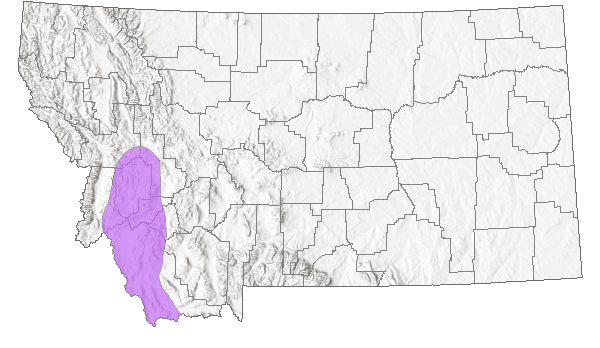
 Native
Native
Range Comments
It is only known from the lower montane zone on the south side of the Garnet Range and the Sapphire Range of Granite county and from a localized area of Beaverhead County.
Observations in Montana Natural Heritage Program Database
Number of Observations: 110
(Click on the following maps and charts to see full sized version)
Map Help and Descriptions
Relative Density
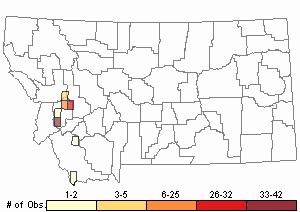
Recency
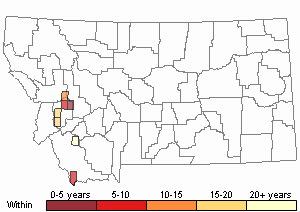

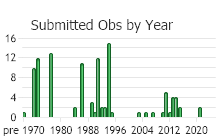
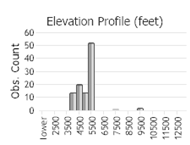 (Observations spanning multiple months or years are excluded from time charts)
(Observations spanning multiple months or years are excluded from time charts)
Habitat
Gravelly, calcareous grassland slopes in the foothills zone.
National Vegetation Classification System Groups Associated with this Species
Alpine
Alpine - Sparse and Barren
Forest and Woodland
Low Elevation - Xeric Forest and Woodland
Shrubland
Sagebrush Shrubland
Grassland
Lowland - Prairie Grassland
Sparse and Barren
Sparse and Barren
Stewardship Responsibility
Threats or Limiting Factors
STATE THREAT SCORE REASON
Reported threats to Montana's population of Keeled Bladderpod refer to declining density of populations with extensive non-native plant invasions (MTNHP Threat Assessment 2021). Aggressive Cheatgrass (Bromus tectorum) and Spotted Knapweed (Centaurea stoebe) populations occur in the vicinity of most known populations, and the latter has become the dominant plant at many sites. Keeled bladderpod is small-statured and associated with sparsely vegetated habitat, and unlikely to remain viable in competition with tall or dense exotics. Minor threats from livestock trampling and grazing potentially accelerate the spread of non-natives and may impact populations more severely when paired with other stressors.
References
- Literature Cited AboveLegend:
 View Online Publication
View Online Publication MTNHP Threat Assessment. 2021. State Threat Score Assignment and Assessment of Reported Threats from 2006 to 2021 for State-listed Vascular Plants. Botany Program, Montana Natural Heritage Program, Helena, Montana.
MTNHP Threat Assessment. 2021. State Threat Score Assignment and Assessment of Reported Threats from 2006 to 2021 for State-listed Vascular Plants. Botany Program, Montana Natural Heritage Program, Helena, Montana.
- Additional ReferencesLegend:
 View Online Publication
View Online Publication
Do you know of a citation we're missing? Achuff, P. L. and L. A. Schassberger Roe. 1991. Weeds and rare native plants in Montana. Proc. Weed Symposium (1991): 18-23.
Achuff, P. L. and L. A. Schassberger Roe. 1991. Weeds and rare native plants in Montana. Proc. Weed Symposium (1991): 18-23. Al-Shehbaz, I. A. and S. L. O'Kane. 2002. Lesquerella is united with Physaria (Brassicaceae). Novon 12:319-329.
Al-Shehbaz, I. A. and S. L. O'Kane. 2002. Lesquerella is united with Physaria (Brassicaceae). Novon 12:319-329. Culver, D.R. 1994. Floristic analysis of the Centennial Region, Montana. M.Sc. Thesis. Montana State University, Bozeman. 199 pp.
Culver, D.R. 1994. Floristic analysis of the Centennial Region, Montana. M.Sc. Thesis. Montana State University, Bozeman. 199 pp. Lesica, P., M.T. Lavin, and P.F. Stickney. 2012. Manual of Montana Vascular Plants. Fort Worth, TX: BRIT Press. viii + 771 p.
Lesica, P., M.T. Lavin, and P.F. Stickney. 2012. Manual of Montana Vascular Plants. Fort Worth, TX: BRIT Press. viii + 771 p. Lesica, P., M.T. Lavin, and P.F. Stickney. 2022. Manual of Montana Vascular Plants, Second Edition. Fort Worth, TX: BRIT Press. viii + 779 p.
Lesica, P., M.T. Lavin, and P.F. Stickney. 2022. Manual of Montana Vascular Plants, Second Edition. Fort Worth, TX: BRIT Press. viii + 779 p. Rollins, R. C. 1993. The Cruciferae of Continental North America: systematics of the mustard family from the Arctic to Panama. Stanford University Press, Stanford, California. 976 pp.
Rollins, R. C. 1993. The Cruciferae of Continental North America: systematics of the mustard family from the Arctic to Panama. Stanford University Press, Stanford, California. 976 pp. Schassberger, L.A. 1991. Status Review of Lesquerella carinata and Lesquerella paysonii USDA Forest Service - Region 1 Deerlodge National Forest. Prepared for the USDA Forest Service, Region 1, Deerlodge National Forest, Montana. Montana Natural Heritage Program, Helena, MT 40 pp.
Schassberger, L.A. 1991. Status Review of Lesquerella carinata and Lesquerella paysonii USDA Forest Service - Region 1 Deerlodge National Forest. Prepared for the USDA Forest Service, Region 1, Deerlodge National Forest, Montana. Montana Natural Heritage Program, Helena, MT 40 pp. Vanderhorst, J.P. 1995. Report on the conservation status of Lesquerella carinata var. languida, a candidate threatened species. Unpublished report to the Bureau of Land Management and the U.S. Fish and Wildlife Service. Montana Natural Heritage Program, Helena, Montana 56 pp.
Vanderhorst, J.P. 1995. Report on the conservation status of Lesquerella carinata var. languida, a candidate threatened species. Unpublished report to the Bureau of Land Management and the U.S. Fish and Wildlife Service. Montana Natural Heritage Program, Helena, Montana 56 pp.
- Web Search Engines for Articles on "Keeled Bladderpod"





